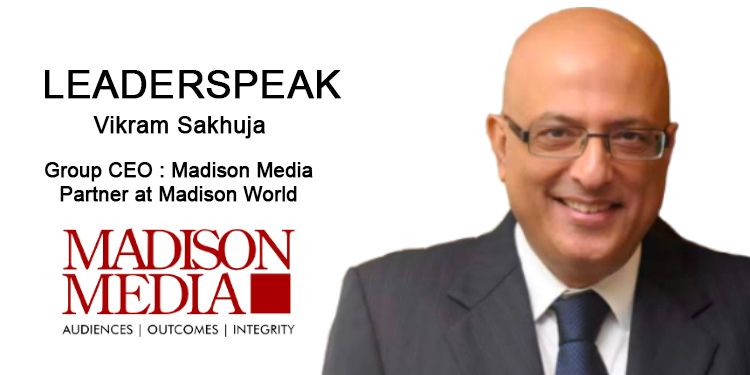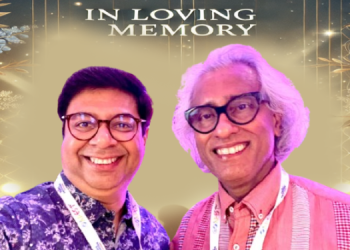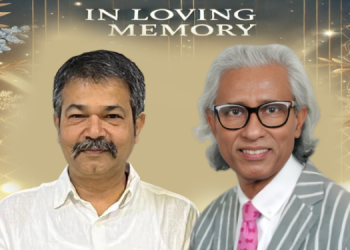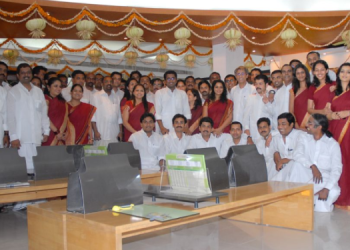Mumbai: This year the Adex will grow by 12% and cross Rs. 1.11 lakh crore according to the Madison Media Ad Report 2024. In 2023 the Adex grew by 10% versus the projection of 16% growth. This was the lowest growth in six years, apart from the Covid year. TV grew by 7%. This is a far cry from the comfortable double digit growth that TV has enjoyed in the not too distant past.
Speaking to Medianews4u.com Group CEO:Madison Media, partner at Madison World Vikram Sakhuja said that fragmentation is a big challenge for TV to get back to double digit ad revenue growth. “Currently, video supply has now increased like mad with the entire digital piece. YouTube and pther platforms haves now expanded the digital supply.
“So earlier if I had 4 million, all India GRPs that I could buy on TV, those things remain the same maybe 1% this way or that way. But the big fact is that all in addition to all of that, you also got YouTube and all the other OTTs and everything else which has come in. So as a result, it’s always going to be the supply being much more, it’s going to be a little bit of a challenge for TV to, to sort of grow back.”
He explains that for TV to grow back one needs to have some kind of ability to pay a premium. “Today, the big problem with digital, TV, in fact, the whole media environment is a high degree of fragmentation. So if you look at the number of programs on TV with more than one rating, it’ll probably be less than 1%. And if you look the same thing on digital, it’ll be even more aggravated.”
The key to getting a premium is delivering reach with fewer GRPs. “If you are able to, on TV, get a few good programs, I mean, if you’re able to get your average ratings up, you’re able to drive reach better. And therefore if you require fewer GRPs to get the same reach then you can command a premium. Barc has around 400 or so channels, which it reports. Now, currently most large businesses have anything from 150 to 200 clients for 150- 200 channels. You have to able to bring the number of channels down.” He added that actually last year there have been very few channel launches. “In the middle there always used to be some amount of channel launches that would fragment the game further.” The key according to him is that the same inventory should give more ratings. Then broadcasters will be able to charge more and that’s what’s going to drive up overall growth.
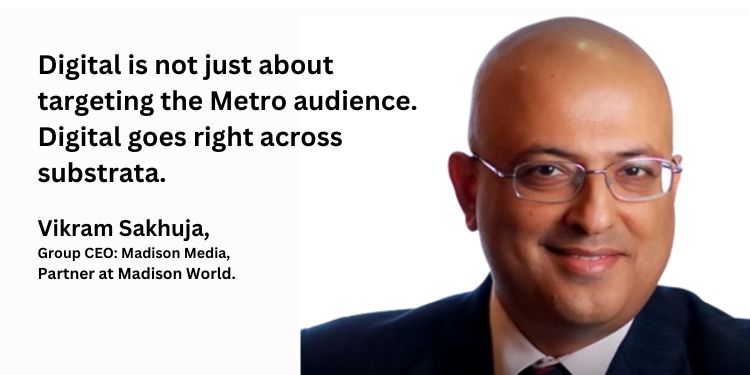 Disney-Star Viacom18: There have been reports about the two media conglomerates looking at coming together. When asked if this is a step in the right direction he said that it depends entirely on how they will drive channels, or what they will do. “Consolidation is obviously the first step to this. If you consolidate, then you have the option of saying, let’s cut out a few channels and try to consolidate.” But he also points out that people when they have to make the decision of shutting down channels they don’t want to lose those ratings completely to an outside party.
Disney-Star Viacom18: There have been reports about the two media conglomerates looking at coming together. When asked if this is a step in the right direction he said that it depends entirely on how they will drive channels, or what they will do. “Consolidation is obviously the first step to this. If you consolidate, then you have the option of saying, let’s cut out a few channels and try to consolidate.” But he also points out that people when they have to make the decision of shutting down channels they don’t want to lose those ratings completely to an outside party.
“So I am sure that it’s a tough call for them. But yes, if you consolidate and two large networks that have say 100 channels bring that number down then that will reduce fragmentation.”
Tentpole Properties Are Losing Steam: Sakhuja also noted that while tentpole properties are important on TV they have to deliver better in terms of reach and ratings.
“Increasingly if you look at all of them, whether it’s a ‘KBC’, or ‘Indian Idol’, or ‘Jhalak Dikhhla Jaa’ or ‘India’s Got Talent’, I mean, all of these over the years, they are the premium properties, but they have been losing ratings over the years. ‘Bigg Boss’ to some extent has held on to ratings, as has IPL. They are the exceptions to this. Even though ‘Bigg Boss’ is struggling to keep up it is holding on. It is not coming down. But of course if you have a good property, then you can definitely build up extractions through that.”
Tentpoles he said have always helped get extractions up and build up margins for the broadcasters. “But in the past tentpoles were also associated with high return high reach. That part is becoming diluted. They need to rediscover that.”
IPL: He said that both the IPL and the Elections will be sizable. But the rights of the IPL being split saw Disney-Star India making a little less on TV last year on advertising on IPL. “This year there will be some growth on that.” Startups going slow on ad spend hurt the IPL ad revenue situation to an extent last year. What also hurt Disney-Star India last year was JioCinema going all out to get ad revenue.
“JioCinema went a little bit more aggressive. When Star had the IPL rights for TV and digital I still thought that they were trying get more from TV than from the Hotstar piece. Last year when two different platforms aired the IPL JioCinema went hammer and tongs, They had free distribution and they just made sure that everybody was seeing it. And also they were very aggressive when it came to selling it. So I think to some extent, some of the money which would have otherwise gone to TV went to them:”
He is not sure whether the T20 World Cup will grow the sports ad pie this year given that last year there was the ODI World Cup. “This year we have the T20 World Cup. Last year we had the ODI World Cup. So I don’t know whether they will negate each other or if there will be an incremental increase beyond that. But all these are things that you factor in when you make the Adex.”
The elections he explains is going to be fresh money.
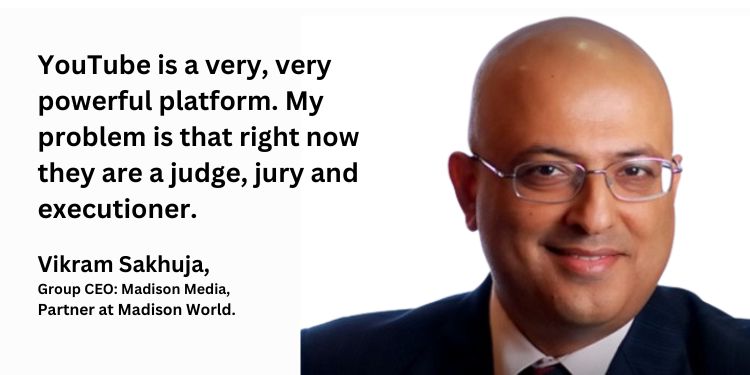 TV Plus Digital Effective for Advertisers: He noted that for advertisers this strategy works given that digital basically reaches all kinds of consumers now. “The reality is that you have some people who are really diehard TV viewers, and you can do an entire media plan with them. And for some people who shave the cord or cut the cord, as they say, you do need to get them on digital”.
TV Plus Digital Effective for Advertisers: He noted that for advertisers this strategy works given that digital basically reaches all kinds of consumers now. “The reality is that you have some people who are really diehard TV viewers, and you can do an entire media plan with them. And for some people who shave the cord or cut the cord, as they say, you do need to get them on digital”.
He points out that digital is effective in getting the youth piece. Moreover digital is not just about targeting the Metro audiences. “Digital goes right across substrata. There are some cohorts which are better, sort of reached through digital.. Even for people who are doing reach based planning, they find that beyond a point TV plateaus. So when you reach that point in time you buy digital. Then you can actually get reach at a lower cost.”
Digital he explains is probably about 30% of the entire video economy and that changes from category to category. “But you could say that, roughly that’s where it is.”
YouTube: He said that YouTube is very powerful. But the lack of third party measurement is an issue. He feels that advertisers who invest in digital should insist on third party data. It should not be that Google or Meta are only taken at their word when it comes to data.
“There’s no question about YouTube being powerful. And YouTube also has technology on their side. They address the problem of fragmentation. If you typically want to build reach at higher frequency on any platform, that’s a fragmentation challenge.
“So suppose somebody burns up 100 million impressions on YouTube, you might reach however you define a target audience, you might reach, say 60% once. But the minute you have to reach people twice or thrice by the time you have burned 100 million impressions you have barely reached 10 – 15% at three. Now they’ve got a product now called Targeted Frequency where you give them a three plus kind of reach, and they’re able to deliver that.”
Resistance To Third Party Data: He points that the good thing about Google really is they’ve got some fantastic technology “The part which I’m not comfortable is that YouTube is a huge platform. People should not view it as a channel. So it’s a platform and on this platform firstly, you have to rely on YouTube’s own data for measuring everything – reach, frequency. They will give you a laundry list, a dump of sort of content around which your ads will place. But to make any sense of them is very difficult.”
It is not like TV. “On TV you place a spot around a certain program so that could be music, general entertainment, movies, music etc. You put a spot there, and you aggregate the audiences throughout the people who are watching the content. So I can make a spot plan and share it with all my stakeholders and say, this is where you’re likely to see your ads.
“The same thing you cannot do on YouTube in general, because you’re giving the audience profile to people, wherever, whatever they’re watching, and you might give some exclusions, But whatever they’re watching, your ad might come there. So you at the end of the campaign, know very clearly where your ad was placed on YouTube.”
He said that from feedback he has heard often ads are actually placed on cartoon content. “It’s quite possible that you might be having an adult male as the target audience, but because your kid is playing with a phone, he/she is watching cartoons and all and your ads are coming there. If that’s the case, it’s a wasted impression.
“YouTube is a very, very powerful platform. My problem is that they are right now judge, jury, executioner. So they will give you everything, they’ll give you the data, they’ll tell you the reach. If you try to go and tell them after that ‘no, through third party, I’m getting different data’ you still have to convince them because they will say, ‘I don’t know whether I can trust somebody else’s tech platform or data. Mine is correct.’ So my problem with YouTube is that. Is it a powerful medium? Of course, it is a powerful platform.”
No Cross Media Measurement: For third party measurement on digital one needs cross media measurement at the industry level. “We have discussed it at Barc but nothing’s moved forward right now.
“According to me crossmedia is looking at an environment where digital has become so big and, and every individual in India, are now consuming things on both TV and handheld and CTV and all that kind of stuff. It becomes imperative to have a third party measurement, which captures both. Is should have been done two years back. But right now, it’s still not happening. And that’s a problem.”
FAST: Talking about the potential of Free Ad Supported TV (FAST) he noted that today’s Connected TV (CTV) is about 20- 25 million homes, which is about 10-12% of total Indian TV homes. “I don’t have a very good fix on cord cutters. People on smart TVs are still able to go to YouTube, in some cases, download apps, in some cases, put Amazon stick and try to get content from there, and so on and so forth.”
He explains that as CTV grows more and more, ad funded streaming platforms will come in. He gives the example of Roku in the US. “They are the ones who actually aggregate a bunch of streaming platforms and put them together and sell ads on them. So I think it’s going to happen and as CTV picks up steam, it’ll happen more.”
A.I.: He noted that A.I. has been happening in some form or the other for the past few years. “If you have to extract the essence of what we do in media planning, we finally tell people how to use their ad money. Firstly it is an allocation thing. What money people should be putting money behind what targeting. Within that what should the media mix be? What media touchpoints and how much money to put in each? So there’s a lot of allocation based decisions,”
The second aspect he notes is optimisation. What is the best strategy to follow to reach more people with fewer GRPs, or impressions.
“The third aspect is attribution where you try to find out that if I put a spot somewhere, what it will do for my business. In each of these, there is a bunch of A.I. already at play. So, for example, Google’s ADH product, which they came out with some three, four years, back or something, it’s a very good it’s a AI model, which learns from a number of iterations and stuff like that.”
He notes that while Google and Meta are doing work in A.I. other companies have also come in. “Supposing I’m doing like YouTube or top of the funnel kind of advertising it will tell you what impact it is making on my bottom line. It’s able to give you some kind of learning, and that’s a A.I. kind of product. There are two things. First the best technology and AI is coming from the big platforms which are Google and Meta. But there’s also a bunch of intermediate level players like Pixus, MiQ. SkyBridge.
“There are a bunch of them who come in, and who allow you to get more out of the platforms. If you, sort of connect with them, then you’re able to extract more. So all of these are, most of them are all based on, you know, basically machine learning. So you’ll put in an algorithm, see how it’s done. And then it learned through that and say that okay, now, next time try this.
“So all the entire lookalike audiences and all is Al. Customers may be immediate, but look alike is learning from them. And saying that if you went to these guys and got some business, chances are if you go to those guys, you will also get. So all that is already happening. So will that scale up? I guess it will scale up.”
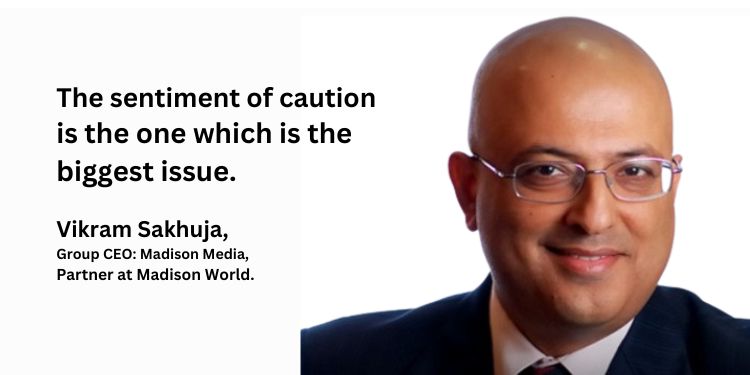 Adex Challenges: Sakhuja mentions global uncertainty being a potential issue this year in terms of the adex growing. “I think that global uncertainty is led by the global economy not doing that great. There are a couple of wars happening, which is never nice.
Adex Challenges: Sakhuja mentions global uncertainty being a potential issue this year in terms of the adex growing. “I think that global uncertainty is led by the global economy not doing that great. There are a couple of wars happening, which is never nice.
“So look, there is instability, and I think that’s creating a problem.” He points that if there is a good, stable environment then marketers are confident. “Then they will take long term punts, they will have annual plans, all the rest of it. But if there’s a high degree of volatility, they go quarter by quarter. Currently our observation is that people seem to be protecting the bottom line. In fact this was validated by BCG.” He said that if one looks at the entire market cap, and what drives share movements, and so on, so forth, it’s much more volume.
“So the story to the street is that, I’m able to grow volume and of course, grow volume responsibly, not the burn rate ones. If you’re able to, grow volumes responsibly, then markets respond better than if you’re able to show profits just by cutting investments. So I think that currently the environment has been one where people have been very cautious in terms of investments. So to my mind the sentiment of caution is the one which is the biggest issue.”
He added that global uncertainty impacts the global MNC probably a little bit more, because now when you’re part of a global thing, and if a few very, very large Western markets are not kicking in well then then it will impact investments that one make in a local market. “But, even from a local player standpoint, these kinds of things, whether it is the exchange rates, or the fed rates being high and FDI being controlled or the economy’s not doing that great has an effect. So the global thing is creating some kind of pressure on India.” He also noted that while the premium end is doing well right now the mass end is threatened.
His sense is that post elections everybody expects that the current government will come back. “I think that from a stability standpoint, that would be a very good thing. Because once they come back, also, they come back with a, with a resounding sort of mandate and all that. They come out with some more reforms, and I think we’ll find ways to get consumption amongst the masses to also go up. I think that will all help the economy.
“So I would say that, yeah, it’s cautious optimism, these global pressures and to some extent, some need for reforms, which impact the mass market. These are the two things which can actually provide the wind behind the sails.”
Startup Ad Spends to Stay Depressed: He noted that the startup ad spending will stay depressed for at least the first half of the year. “The startup winter or whatever you call it will be likely continue for at least the first half of the year.”

